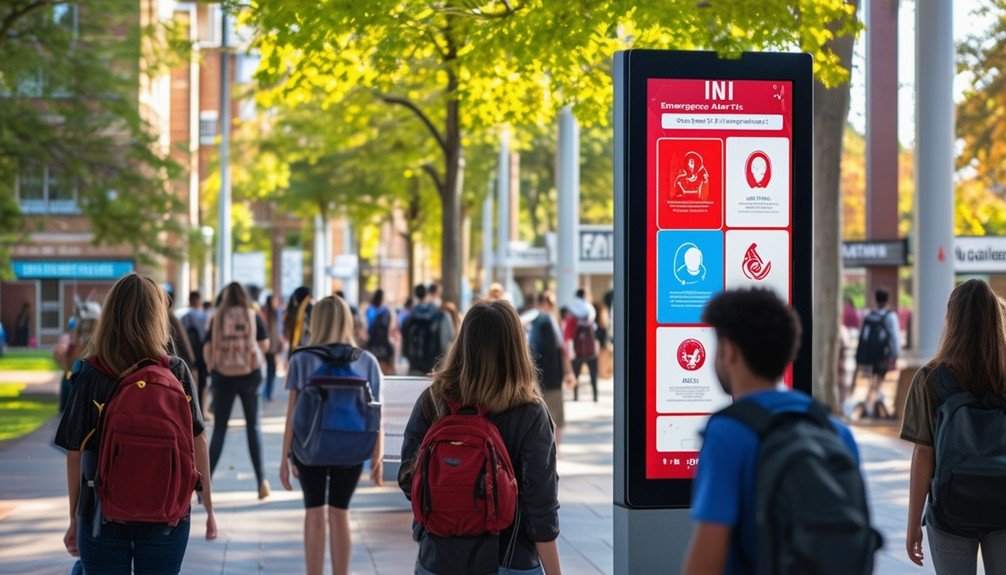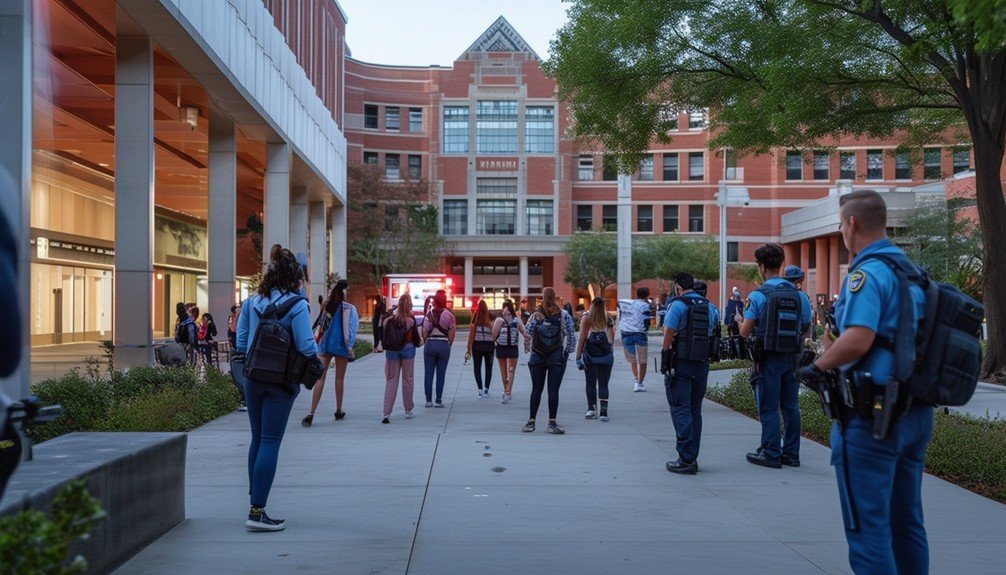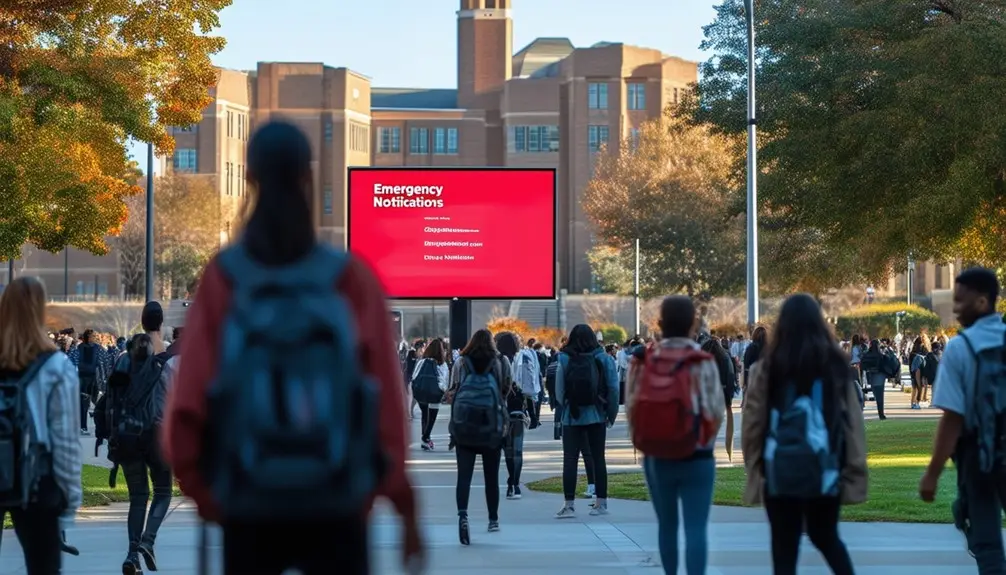You can improve university safety by repurposing existing digital signage for emergency notifications. These displays can provide crucial information, such as evacuation routes and shelter-in-place instructions. With tailored, geo-specific alerts, you’ll provide precise guidance to affected areas. Deploy signs in high-traffic zones to maximize visibility, using color-coded alerts for quick recognition. Centralized control guarantees coordinated messaging, and analytics help refine your strategy. Instant, real-time updates capture immediate attention with dynamic visuals. This method is cost-efficient and leverages current technology for effective communication. Discover more about optimizing your emergency notification system and boosting campus safety.
Key Takeaways
- Repurpose campus digital displays to broadcast real-time emergency alerts, evacuation routes, and shelter-in-place instructions.
- Utilize geo-specific messaging to deliver tailored alerts and guidance to specific campus locations affected by emergencies.
- Place digital signage in high-traffic areas for maximum visibility and effective emergency communication.
- Implement instant message distribution through digital displays to relay urgent messages simultaneously across campus.
- Ensure digital signage systems are compatible with emergency alert providers using standardized CAP protocols for efficient communication.
Leveraging Existing Infrastructure

By leveraging the current campus infrastructure, universities can efficiently implement digital signage for mass emergency notifications. You can utilize the already-installed digital displays across the campus to disseminate emergency alerts quickly. This approach maximizes the utility of your existing system, making sure that you don’t need extensive new installations.
When an emergency arises, digital signage can instantly display emergency alerts, providing critical information to students, faculty, and staff. For example, these digital messages can include evacuation routes, shelter-in-place instructions, or imminent danger warnings. Leveraging digital signage not only enhances communication speed but also ensures that the emergency messages are clear and visible to everyone on campus.
The existing network of digital displays integrated into your campus infrastructure can be adapted to support an emergency alert system. This means you can use screens in common areas, lecture halls, and dining facilities to broadcast real-time emergency information. By doing so, you ensure that your emergency messages reach a wide audience simultaneously, enhancing overall campus safety.
This strategy provides a cost-effective solution, maximizing your return on investment by repurposing current technology for critical safety communications without the need for significant additional expenditures.
Geo-Specific Messaging
In addition to utilizing existing infrastructure, geo-specific messaging enables universities to deliver tailored emergency alerts to precise locations on campus, guaranteeing relevant and actionable information reaches those in immediate danger. This targeted approach means you can customize alerts based on the geographical area directly impacted by the emergency, enhancing campus safety and improving emergency response coordination.
When an incident occurs, geo-specific messaging provides location-specific guidance through digital signage, making certain that individuals in affected areas get the right instructions for their immediate surroundings. This ensures that the information they receive is not only timely but also pertinent to their specific situation, which enhances the overall effectiveness of emergency notifications.
Imagine an emergency requiring evacuation only in certain buildings; geo-specific messaging allows you to send tailored emergency alerts exclusively to those areas. This method avoids unnecessary panic in parts of the campus not affected, maintaining order and streamlining emergency response efforts. By focusing on specific locations, you can guarantee that your emergency protocols are executed efficiently and effectively. Utilizing digital signage for this purpose not only disseminates relevant information quickly but also plays an essential role in safeguarding lives and maintaining order during crises.
Deployment in Multiple Locations

Strategically deploying digital signage in 7 pedestrian and 4 vehicular signs across the university campus ensures maximum visibility and efficiency during emergencies. By placing these signs in high-traffic areas and at key campus gateways, you make certain that urgent safety messages reach students, staff, and visitors promptly. These digital signs provide critical directions to parking lots and buildings while also displaying emergency notifications that can save lives.
The deployment in multiple locations is managed through a central management system, allowing the Emergency Management team to quickly take over and deliver coordinated messaging. This system guarantees that all signs display consistent information, reducing confusion during a crisis. Color-coded alerts, such as Red Emergency Alerts and Orange Safety Warning Alerts, are employed for easy recognition and swift response.
Pedestrian signs and vehicular signs serve different but complementary roles. Pedestrian signs focus on areas where foot traffic is heavy, ensuring that those on foot receive timely updates. Vehicular signs, on the other hand, guide drivers efficiently while keeping them informed of any urgent safety messages. This coordinated approach maximizes the reach and effectiveness of emergency notifications, safeguarding the entire university community.
Enhancing Communication Speed

You can enhance communication speed by utilizing instant message distribution through your digital signage network. Rapid visual alerts guarantee that important information reaches students and staff immediately. This immediate response coordination is essential for maximizing safety and minimizing confusion during emergencies.
Instant Message Distribution
Leveraging digital signage for emergency notifications drastically enhances communication speed by instantly distributing tailored messages across university campuses. By using existing digital signage infrastructure, you can guarantee efficient communication during crises. Emergency alerts can be geo-specific, delivering the right information to the right locations, guaranteeing widespread coverage and immediate action.
Utilizing digital signage for instant message distribution offers several key benefits:
- Efficient Communication: Digital signage systems can relay urgent messages in real-time, guaranteeing that everyone on campus receives critical information simultaneously.
- Crisis Communication: In the event of an emergency, tailored messages can be quickly created and displayed, providing clear instructions and updates to students, staff, and visitors.
- Widespread Coverage: With multiple digital signage points across university campuses, you achieve extensive reach, guaranteeing no area is left uninformed.
- Eye-catching Displays: The use of bright, dynamic visuals guarantees that emergency notifications capture attention immediately, making the dissemination of urgent messages highly effective.
Rapid Visual Alerts
Digital signage’s rapid visual alerts greatly enhance communication speed during emergencies, guaranteeing timely and effective dissemination of critical information. When you utilize digital signage for emergency notifications, the visual alerts capture attention quickly, ensuring urgent messages are immediately noticed. This swift action is vital in situations requiring rapid responses, such as campus lockdowns or severe weather warnings.
| Feature | Benefit | Outcome |
|---|---|---|
| Rapid Visual Alerts | Immediate Attention | Swift Action |
| High Visibility | Enhanced Message Retention | Increased Awareness |
| Real-Time Updates | Timely Communication | Prompt Decision Making |
| Dynamic Content | Engaging and Clarity | Effective Message Dissemination |
Digital signage guarantees timely communication by displaying emergency notifications in real-time. The high visibility and dynamic nature of these visual alerts mean they stand out, enhancing communication speed and ensuring that the critical information is retained by the audience. Implementing digital signage for urgent messages helps in achieving a rapid response and can be pivotal in managing potentially dangerous situations.
Immediate Response Coordination
Rapidly disseminating emergency notifications across campus through digital signage is crucial for guaranteeing immediate response coordination and enhancing communication speed. When an emergency arises, your ability to quickly inform students, faculty, and staff can be a game-changer for campus safety. Digital signage provides a robust solution for immediate dissemination, leveraging existing infrastructure to deliver tailored alerts where they’re needed most.
Using geo-specific messaging, you can target specific areas of the campus, ensuring that the right people get the right information at the right time. Here are four key benefits:
- Immediate Dissemination: Digital signage guarantees that emergency notifications are broadcast instantly, reducing reaction times and enhancing emergency response coordination.
- Tailored Alerts: Customize messages for specific locations using geo-specific messaging. This guarantees that only those in affected areas receive critical updates, avoiding unnecessary panic.
- Widespread Coverage: Deploy digital signage in multiple, strategic locations to guarantee campus-wide reach, maximizing the chances that everyone sees the alert promptly.
- Utilizing Existing Infrastructure: By integrating with current systems, digital signage can quickly become a seamless part of your emergency response plan, boosting communication speed without requiring extensive new installations.
In an emergency, every second counts. Digital signage can make those seconds work in your favor.
Utilizing Analytics and Integrated Plans

To improve your emergency notification system’s effectiveness, use analytics to track message engagement and impressions. By analyzing data from high-traffic areas and demographic insights, you can optimize communication strategies and guarantee the timely dissemination of vital information. Integrated plans will coordinate digital signage with other alert systems, offering a holistic approach to campus safety.
Tracking Message Effectiveness
By leveraging advanced display technology and thorough analytics, universities can precisely track the effectiveness of their emergency notifications and make data-driven improvements. Utilizing digital signage enables you to gather valuable data, such as impressions and engagement time, providing insights into how well your emergency messages are being received.
Integrated communication plans guarantee that messaging is coordinated across all digital signage platforms. This level of coordination is essential for tracking effectiveness and making informed decisions. Here’s how you can do it:
- Analytics Integration: Implement analytics tools to measure the performance of your emergency messages. Track metrics like impressions and engagement time to understand the reach and impact.
- Coordinated Messaging: Develop integrated communication plans that synchronize messages across all digital signage. This ensures consistency and reliability in your emergency notifications.
- Targeted Placement: Identify high-traffic areas using analytics. Place digital signage in these locations to maximize the visibility and effectiveness of your messages.
- Tailored Messages: Use the gathered data to tailor your emergency messages. Adjust the content based on the audience and location to ensure maximum engagement and response.
High-Traffic Area Insights
Leveraging high-traffic area insights through advanced analytics and integrated plans allows universities to strategically place digital signage for best emergency communication. By effectively utilizing analytics, you can identify the most frequented locations on campus, guaranteeing that emergency notifications are visible where students, faculty, and staff are most likely to see them.
Incorporating demographic data into your integrated plans guarantees that these notifications reach the right audiences. For instance, knowing the demographic makeup of specific high-traffic areas can help tailor messages to be more relevant and engaging. Tracking impressions and engagement time in these areas provides crucial insights into the effectiveness of your emergency messages, allowing you to adjust your strategy as needed.
Digital signage placement in high-traffic areas enhances the speed and reach of emergency communication, making it a crucial part of thorough strategies for campus safety. By targeting specific areas with tailored emergency notifications, you can maximize the impact of your messages. This approach ensures that everyone on campus receives timely, accurate information in an emergency, thereby improving overall campus safety and preparedness. Implementing these data-driven strategies creates a more resilient and responsive emergency communication system.
Addressing Individualized Responses

Recognizing the diverse needs of individuals, universities must implement digital signage systems that provide tailored emergency notifications to safeguard everyone’s safety. Enhancing emergency response efficiency requires acknowledging that students, faculty, and staff have varied individualized responses to crises. By focusing on personalized emergency notifications, you can secure a timely and orderly crisis response.
To achieve this, universities should adopt versatile systems that allow for a set-and-forget approach, ensuring that once set up, these systems function autonomously. A safety focus is paramount, and optimizing digital signage effectiveness can be achieved by addressing the following:
- Segmented Messaging: Customize messages based on different campus zones and the specific needs of various groups, ensuring clear and precise information reaches everyone.
- Multilingual Support: Offer notifications in multiple languages to address the diverse linguistic needs of the university population.
- Accessibility Features: Integrate features such as text-to-speech and visual aids for individuals with disabilities, securing inclusivity.
- Adaptive Content: Design the system to automatically adjust messages based on the type and severity of the emergency, providing relevant information for varied individualized responses.
Timeless Best Practices

Ensuring that digital signage systems operate seamlessly during emergencies requires adherence to timeless best practices that enhance the clarity, visibility, and effectiveness of notifications. A consistent layout is essential, as it aids in wayfinding during crises, providing clear and easy-to-follow emergency instructions. When designing your digital signage, maintain a uniform format for emergency notifications, making it easier for users to quickly comprehend critical information.
Attention-grabbing displays are important in guaranteeing that emergency alerts capture the audience’s focus. Utilize bright colors and bold text to make notifications stand out, ensuring they are visible even in crowded or busy environments. This approach significantly boosts campus safety efforts.
Leveraging digital signage for emergency notifications not only promotes safety but also ensures a high return on investment. By integrating these systems into your existing infrastructure, you maximize their utility for both regular updates and urgent mass notifications.
Keeping non-emergency content fresh is another best practice. By regularly updating your displays, you maintain engagement and prepare individuals for emergency alerts, making sure they pay attention when critical messages appear. Adhering to these timeless best practices ensures universities can effectively use digital signage to manage emergencies and safeguard their communities.
Emergency Alert System Features
A robust emergency alert system for digital signage should integrate features like quick installation, seamless compatibility with various providers, and standardized protocols to guarantee efficient and effective communication. By leveraging digital signage, you guarantee critical information reaches your campus community swiftly and clearly.
To enhance your emergency alert system, consider these key features:
- Quick Installation and Simple Deployment: Using software like Rise Vision, you can rapidly set up and deploy an emergency alert system without needing a credit card. This simplicity guarantees your notification system is always ready for immediate use.
- Smooth Integration: Integrate with various emergency alert providers such as Alertus, AppArmor, and CrisisGo. This compatibility guarantees your digital signage can broadcast emergency communications efficiently across different platforms.
- Standardized Procedures: Employing CAP (Common Alerting Protocol) reduces complexity and costs, allowing for standardized emergency communications. CAP ensures that your notification system integrates smoothly with existing infrastructure.
- Visual Elements: Implementing visual components in your digital signage helps to convey critical information quickly. Clear visuals are essential for guaranteeing that messages are understood instantly by the campus community.
Conclusion
Using digital signage for emergency notifications, you’re leveraging infrastructure like a conductor leading an orchestra, guaranteeing precise, geo-specific messaging across multiple locations. This enhances communication speed, integrates analytics, and supports individualized responses. Adopting these timeless best practices and robust emergency alert system features, you’ll create a safer university environment, prepared for any situation. Your proactive approach in deploying these solutions guarantees you’re always one step ahead, safeguarding your community effectively.
Frequently Asked Questions
What Is an Example of an Emergency Notification Message?
An example of an emergency notification message is a ‘Red Emergency Alert’ for critical emergencies. This message is color-coded to indicate high severity and should be distributed through all communication channels to guarantee everyone’s awareness.
What Is the Best School Alert System?
Did you know that 73% of schools improved response times using integrated alert systems? The best school alert system leverages CAP integration, like Rise Vision, to streamline emergency protocols, ensuring quick, effective communication with minimal setup complexity.
What Is Emergency Notification Software?
Imagine an emergency strikes-what do you do? Emergency notification software jumps into action, rapidly sending critical alerts across multiple channels. With pre-set templates and integration capabilities, it guarantees swift, consistent communication, helping you manage any crisis effectively.





